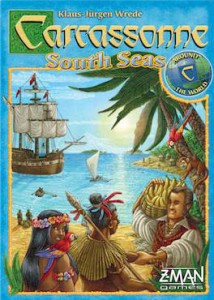Carcassonne: South Seas – First Stop Around the World

Carcassonne fans and newbies alike will love this stand-alone addition to the Carcassonne family of games. Carcassonne: South Seas features gorgeous artwork depicting an island paradise, new Islander meeples, and 60 wooden wares (bananas, shells and fish) in two sizes. As in the original Carcassonne, up to five players can build the landscape, tile by tile, placing meeples to claim features.
What’s different, besides it being an island paradise instead of a medieval town, is that your islander meeples work as shell collectors, banana pickers, merchants or fishermen who collect wares for you (instead of scoring points) when features are completed. You can then sell those wares to merchant ships docked at the islands for end-game points. The ships are very particular about their orders, though. The player with the most points at the end of the game wins.
Meeple managment is particularly important in Carcassonne: South Seas, as you only have four islanders at your disposal. On your turn, you must place a tile, like landscape to like landscape. After placing a tile, you may optionally place an islander (as a banana picker on an island, as a shell collector on a bridge, as a merchant in a market, or floating flat as a fisherman in the sea) or retrieve an islander you placed earlier. If the tile you placed causes one or more occupied Bridges, Islands, Markets or Sea Regions to be completed, an evaluation is made and Wares or Ships are awarded. You can then, if desired, deliver wares to one ship. The wares required by each ship are depicted on its sail. Ships are where you’ll score the most victory points (two to six points each). Leftover wares at the end of the game are only worth one point per three wares, so you’ll want to acquire as many ships as possible to maximize your score.
As noted above, completed features provide goods instead of points. The number of goods you receive, however has nothing to do with how many tiles make up the feature, but instead with how many wares are depicted in the completed feature. Bridges provide the depicted number of shells when terminated at both ends, while completed islands yield bananas.
Sea Regions are the most unique, in that you can trigger an evaluation in two ways: either by completely enclosing it or by placing a tile depicting a fishing boat in the area. In the latter case, the player who triggered the evaluation covers one group of fish in the region with a fishing boat token, after awarding the appropriate amount of fish to the occupying fisherman. Thus, an open sea region can become overfished as it is occupied, scored, depleted (one fish group covered with a fishing boat), then occupied again… It’s a neat new mechanism.
Markets work like the abbeys in the original Carcassonne: they’re considered complete when surrounded by eight tiles. Then they earn the occupier the highest value ship in port!
As in all Carcassonne games, areas can become contested when multiple meeples occupy the same territory with the majority prevailing and ties awarding points to both players occupying the feature. It takes some creative tile placement to horn in on another player’s territory, however, because just like in the original game, you can only place a meeple in an unoccupied region. You may not find yourself contesting features as much, though as you only have four islander meeples to play with.
A game of Carcassonne: South Seas ends when all tiles have been placed or the last ship has been acquired. Final shells, bananas and fish are then distributed for occupied, but incomplete areas. Players add up the points for their acquired ships (2 to 6 points each), plus 1 point for every 3 wares they have left, regardless of type. The player with the highest score wins and is crowned Ruler of the South Seas!
Carcassonne: South Seas supports 2 to 5 players ages 8 and up and plays in about 30 minutes.
Copyright © 2014-2016 by Tina G. McDuffie. All rights reserved.
Photo rights retained by their respective copyright holders.


